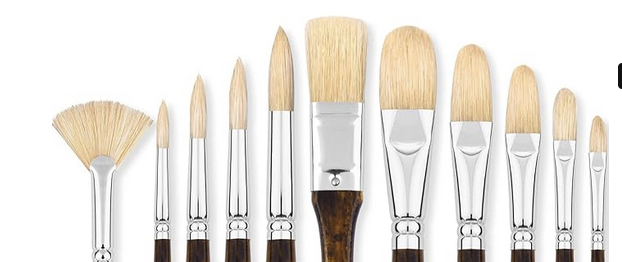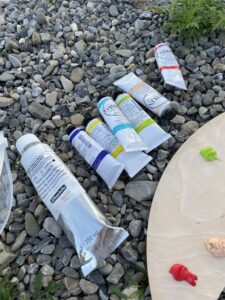So you just started as an oil painter and you’re wondering what brushes to start with. It can be really overwhelming to know what to buy. The aisle of Blick with oil paint brushes is so vast! There are so many different kinds of oil paint brushes.
What oil brushes to start with?
Choosing the right brush shape depends on your painting style and the specific effects you want to achieve. Having a variety of brush shapes in your toolkit allows you to experiment with different techniques and achieve a wider range of artistic expressions in your oil paintings.
But, lets cut to the chase.
To start oil painting, get these brushes:

- a very large filbert
- a variety of flat (square) hog bristle brushes: a small, medium, large.
- one teeny tiny round brush with a pointed tip for details
- one medium size fan brush
- one medium size bright brush
Also, get a medium size palette knife before you start your painting. Trust me.
Here are the types of oil paint brushes:
Hog bristles vs synthetic brushes

Hog Bristle Brushes: Hog bristle brushes are a popular choice for oil painting because they are durable and can handle the thickness and texture of oil paints. They come in a variety of shapes and sizes, making them versatile for different techniques. Look for brushes with natural hog bristles for best results.
Synthetic Brushes: Synthetic brushes have come a long way and can be an excellent choice, especially if you’re concerned about using animal-based materials. They are often more affordable and can work well with oil paints. Look for brushes labeled specifically for use with oils.
Types of oil paint brushes
Oil paint brushes come in various shapes, each designed for specific painting techniques and applications. Here are some of the different shapes of oil paint brushes.
Basic brush shapes
- Round Brushes: Round brushes have a pointed tip and a round, full belly. They are versatile and can be used for a wide range of techniques, from detailed work to broad strokes.
- Flat Brushes: Flat brushes have a square-shaped tip with long, straight bristles. They are excellent for creating sharp edges, blocking in large areas, and making bold, even strokes.
- Filbert Brushes: Filbert brushes have a flat, oval-shaped tip that combines the qualities of round and flat brushes. They are great for blending and creating soft edges.
- Bright Brushes: Bright brushes are similar to flat brushes but have shorter bristles. They provide more control and are suitable for short, controlled strokes and precision work.
- Fan Brushes: Fan brushes have a flat, fan-shaped profile. They are ideal for creating texture, blending, and creating foliage effects, such as leaves and grass.
Additional brushes
Here are some additional brushes that you might like to use as you become more adept at the various oil painting brushes.
Cat’s Tongue Brushes?
Have you heard of Cat’s Tongue Brushes? They have a shape that combines elements of round, filbert, and flat brushes. They are versatile and can be used for various techniques and strokes.
Liner or Rigger Brushes:
Liner or rigger brushes have long, thin bristles that come to a fine point. They are designed for creating fine lines, details, and calligraphy-like strokes.
Mop Brushes:
Mop brushes have a large, round, and soft shape. They are excellent for applying thin glazes, blending colors, and creating soft, delicate effects.
Angular Brushes:
Angular brushes have angled bristles, making them suitable for precise strokes and creating both sharp and rounded edges.
Dagger Brushes:
Dagger brushes have a flat, tapered shape with a sharp point, resembling a dagger. They are versatile for various techniques and can create unique textures.
Palette Knives:
While not brushes, palette knives are essential tools for oil painters. They are used for mixing paint on the palette, applying paint directly to the canvas, and creating textured effects.
Detail Brushes:
Detail brushes are very fine brushes with a pointed tip. They are designed for intricate and precise work, such as adding small details or highlights.
Deerfoot Stipplers: These brushes have a flat, rounded shape with uneven, stippled bristles. They are used for stippling, texturing, and creating special effects.
How many brushes do you need for oil painting?
To start with, I suggest five to ten brushes. You can even just buy a basic oil painting brush set.
Do you need specific brushes for oil?
Yes. You should buy natural hog bristle brushes. They are idea for oil paint because they are stiff and can hold more paint than synthetic brushes.
Brushes really matter while oil painting. It isn’t worth trying to cheap out on your brushes. The reality is that oil painting is expensive. The paint itself is expensive. The oil is expensive. The gesso is expensive. If you are trying to be cheap, then oil painting in isn’t for you. The brushes are really important when you are oil painting and you should get the best you can.
Conclusion
When selecting oil paint brushes as a beginner, it’s a good idea to start with a variety of shapes and sizes to experiment and discover your preferred painting style. Additionally, invest in quality hog hair brushes, as they can last longer and provide better control over your paint application. Taking care of your brushes by cleaning them properly after each use and storing them correctly will also prolong their lifespan.

